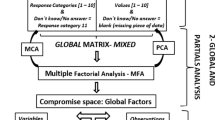Summary
The Social Psychiatry Research Unit at the Australian National University has developed an interview procedure for assessing for research purposes the current state of a person's social relationships — the Interview Schedule for Social Interaction (ISSI). The present paper sketches the origin of the instrument and describes its format and content. The instrument has been used in a sample survey of Canberra, Australia. Data from this survey forms the basis for an analysis of the structure of social interaction. The scoring of data from the interview schedule is discussed, and scores for the answer categories of each question are derived using multivariate analysis of contingencies (MAC). In Part 2 of the paper we shall present tests of hypotheses about the structure of social relationships, using confirmatory factor analysis. The Interview Schedule for Social Interaction, and this analysis based upon it, are believed to constitute the first attempt to give a detailed, ordered and structured account of the field of social relationships, based on representative, large-sample, standardised data collection.
Similar content being viewed by others
References
Berman LF, Syme SL (1979) Social networks, host resistance and mortality. A nine year follow up study of Alameda County residents. Am J Epidemiol 109: 186–204
Blood RO (1967) Love match and arranged marriage. Free Press, New York
Brown GW, Bhrolchain MN, Harris TO (1975) Social class and psychiatric disturbance among women in an urban population. Sociology 9: 225–254
Cassell J (1976) The contribution of the social environment to host resistance. Am J Epidemiol 104: 107–123
Cooper B, Sosna U (1980) The family settings of the psychiatrically disturbed aged. In: Robins LN, Clayton PJ, Wing JK (eds) The social consequences of psychiatric illness. Brunner and Mazel, New York
Duck S (1977) Theory and practice in interpersonal attraction. Academic Press, London
Dohrenwend BS, Dohrenwend BP (eds) (1974) Stressfull life-events: their nature and effects. Wiley, New York
Duncan-Jones P (1972) Preparing social stratification data for path analysis. Soc Sci Inf 11: 189–211. Also in: Müller W, Mayer KU (eds) (1973) Social stratification and career mobility. Mouton, Paris
Duncan-Jones P (1977) Planning and piloting a two-phase psychiatric community survey. Proceedings of the 41st Session, New Delhi. Bull Ind Stat Inst 47: 160–163
Duncan-Jones P, Henderson S (1978) The use of a two-phase design in a prevalence survey. Soc Psychiatry 13: 231–237
Goldberg DP (1972) The detection of psychiatric illness by questionnaire. Institute of Psychiatry Maudsley Monographs, No 21, Oxford University Press, London
Guttman L (1944) Quantification of a class of attributes. In: Horst P (ed) The prediction of personal adjustment. Social Science Research Council, New York
Henderson S (1974) Care-eliciting behavior in man. J Nerv Ment Dis 159: 172–181
Henderson S (1977) The social network, support and neurosis. Br J Psychiatry 131: 185–191
Henderson S (1980) A development in social psychiatry: the systematic study of social bonds. J Nerv Ment Dis 168: 63–69
Henderson S, Byrne DG, Duncan-Jones P, Adcock S, Scott R, Steele GP (1978) Social bonds in the epidemiology of neurosis. Br J Psychiatry 132: 463–466
Henderson S, Duncan-Jones P, Byrne DG, Scott R, Adcock S, Steele GP (1979) Psychiatric disorder in Canberra: a standardised study of prevalence. Acta Psychiatr Scand 60: 355–374
Huston TL (1974) Foundations of interpersonal attraction. Academic Press, London
Kaplan B (1975) Toward further research on family health. In: Kaplan B, Cassel J (eds) Family and health: an epidemiological approach. Institute for Research in Social Science, University of North Carolina, Chapel Hill, NC
Lin N, Dean A, Ensel WM (1979) Development of social support scales. Paper presented to the Third Biennial Conference on Health Survey Research Methods, Reston, VA
McCall GJ, McCall MM, Denzin NK, Suttles GD, Kurth SB (1970) Social relationships. Aldine, Chicago
McCallister L, Fischer CS (1978) A procedure for surveying personal networks. Soc Methods Res 7: 131–148
Miller P, McC, Ingham JG (1976) Friends, confidants and symptoms. Soc Psychiatry 11: 51–58
Riess-Schmeling I (in preparation) Doctoral dissertation. Technische Hochschule, Aachen
Weiss RS (1974) The provisions of social relationships. In: Rubin Z (ed) Doing unto others. Prentice-Hall, Englewood Cliffs, NJ
Wing JK, Cooper JE, Sartorius N (1974) The measurement and classification of psychiatric symptoms. Cambridge University Press, London
Wright PH (1974) The delineation and measurement of some key variables in the study of friendship. Representative Res Soc Psychol 5: 93–96
Author information
Authors and Affiliations
Rights and permissions
About this article
Cite this article
Duncan-Jones, P. The structure of social relationships: Analysis of a survey instrument. Soc Psychiatry 16, 55–61 (1981). https://doi.org/10.1007/BF00582688
Accepted:
Issue Date:
DOI: https://doi.org/10.1007/BF00582688




